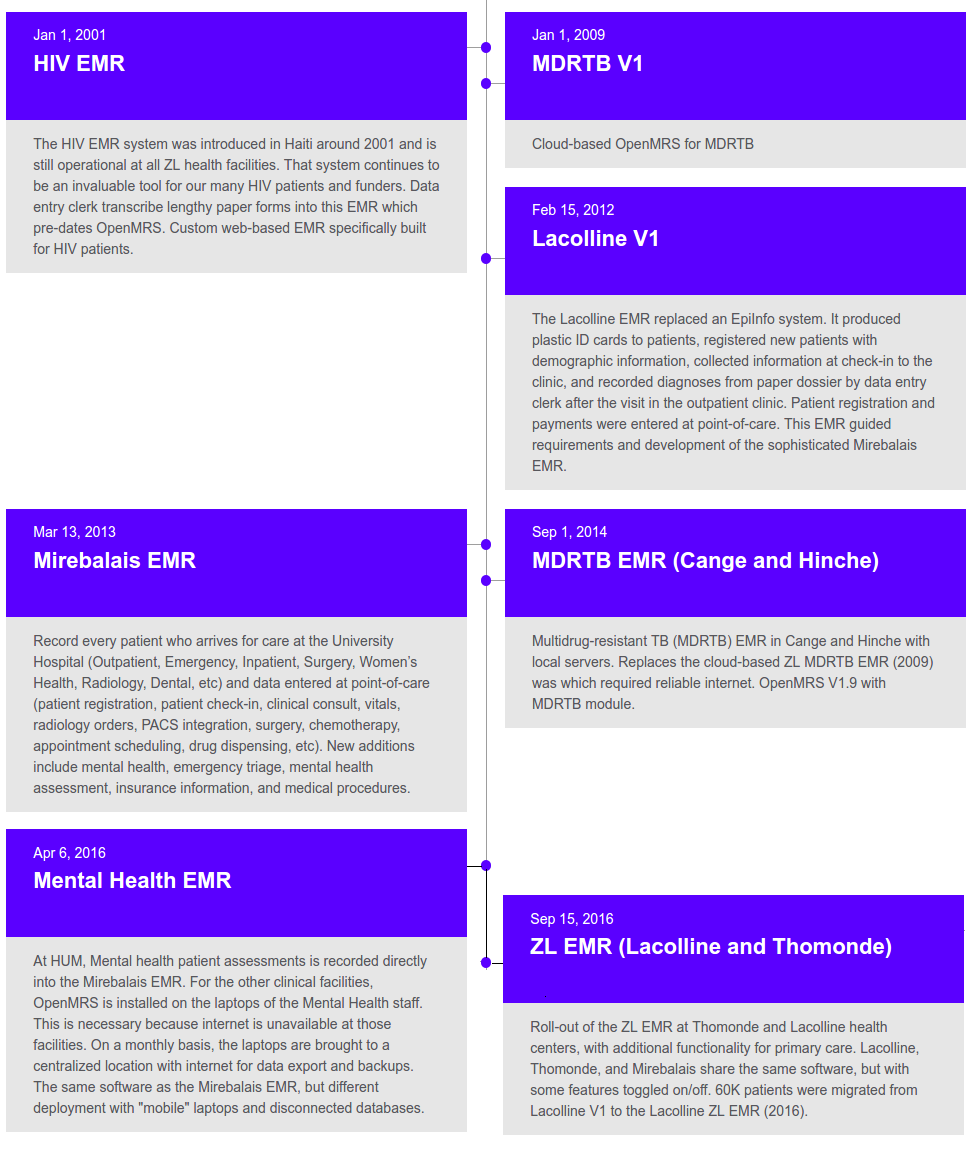The Partners In Health (PIH) program in Haiti, known locally as Zanmi Lasante (ZL), operates clinics and hospitals at 12 sites across the Central Plateau and the lower Artibonite, two of the country's poorest regions. Zanmi Lasante connects vulnerable people in Haiti to comprehensive primary care services and HIV prevention while working in support of the Ministry of Health’s goal of universal treatment coverage. Across all of our sites, PIH/ZL is prioritizing investing in systems that support high-quality, longitudinal care for our patients.
Many Most of our HIV clinics operate based on a pre-OpenMRS HIV electronic medical records (EMR) system with retrospective data entry leading to data backlogs and lower quality data. PIH. OpenMRS implementations have been introduced for MDRTB, Primary Care, Physical Rehabilitation, and Mental Health. PIH/ZL expanded the stable, point-of-care OpenMRS EMR utilized at University Hospital at Mirebalais to our supported clinics at Thomonde Health Center in Thomonde, Haiti and Lacolline Health Center in Lascahobas, Haiti.
This timeline describes the various ZL EMR systems since 2001:. All these systems are built with OpenMRS except the HIV EMR.
Goals
Identify and register all patients at a facility, regardless of program.
Enable clinicians to enter data directly at the point-of-care, leading to reduced data backlogs, higher quality data and improved access to data for patient care. This is accomplished through local server installations that eliminate previous barriers due to internet access.
In the future, leverage this base platform to support our clinical programs by providing timely, accurate, complete data on patients enrolled in HIV, TB, Nutrition, Maternal & Child Health, and other strategic clinical areas. Assist programs with referrals into care, eliminate loss to followup, and evaluate clinical outcomes. Understand the burden of disease along with expanding universal health coverage (UHC).
...
The ZL EMR systems will both enable clinicians and impact patients at all points of the care continuum, from recording diagnosis to mapping treatment plans and retaining HIV patients in our care. Through implementing upgrades, our goals are to identify and register all primary care patients, enable clinicians to enter patient data at the point-of-care, and eventually leverage these systems to provide comprehensive and complete data on all patients. This point-of-care system is used by clinicians and data archivists: Clinicians capture medical information; Archivists capture patient registration and workflow. The ZL EMR primary care functionality includes patient registration, check-in, vital signs, and primary care visit information, including history, vaccinations, allergies, physical exam, diagnoses, and treatment plan.
The same OpenMRS software is used at all three sites (Mirebalais, Thomonde and Lacolline), but with various features toggled on or off, based on the capabilities and workflow at the health facility. (For example, the Radiology interface is only accessible at Mirebalais where there is a PACS system exchanging data with the EMR). The Mental Health EMR is also based on the same software but deployed on multiple OpenMRS servers.
...
All data is entered into the EMR at point-of-care. Registration of all new patients is completed by data archivists (name, gender, birthdate, address, insurance info, mother’s name, contact information, etc).
...
The Lacolline EMR (V2) started on December 5, 2016. 60K patient demographics records were migrated from the Lacolline EMR V1. These were patients who were seen at the Lacolline outpatient clinic between 2012 and 2015. In the first 2 months, over 2,500 patients visited the clinic.
Reports
All data Data is generated from the EMR. Data can be exported for various patient encounters (ie. registration, vitals, visit note, etc.) (Figure 4) . The user customizes data output by date range. Some data is viewed directly by using the web browser and all data can be exported as csv/excel files.
...
